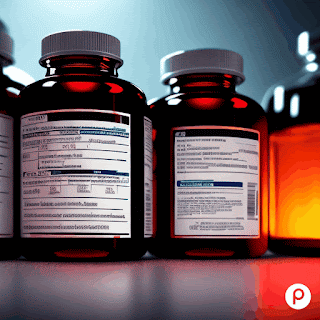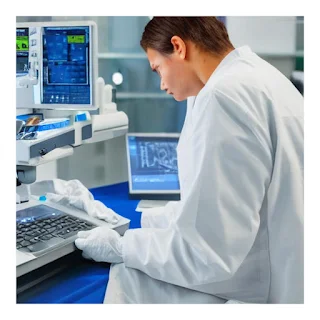Oncology/cancer drugs are medications used to treat cancer. They can be used alone or in combination with other treatments, such as chemotherapy, radiation therapy, and surgery.
Oncology/cancer drugs work by inhibiting the growth and spread of cancer cells, either by targeting specific molecules involved in cancer cell division and survival or by boosting the body's immune system to attack cancer cells. There are various types of oncology/cancer drugs, including chemotherapy drugs, targeted therapies, immunotherapies, and hormone therapies.
Oncology/cancer drugs play a crucial role in the healthcare industry, as they are used to treat cancer, which is one of the leading causes of morbidity and mortality worldwide. According to the World Health Organization (WHO), cancer is the second leading cause of death globally, and it is estimated that about 9.6 million people died from cancer in 2018.
Oncology/cancer drugs are used to treat various types of cancer, including breast cancer, lung cancer, prostate cancer, colorectal cancer, and blood cancers. These drugs can be used alone or in combination with other treatments, such as chemotherapy, radiation therapy, and surgery, to improve the chances of survival and quality of life for cancer patients.
In addition to their clinical benefits, oncology/cancer drugs also have economic importance, as they contribute significantly to the global healthcare industry. The global oncology/cancer drugs market is valued at billions of dollars and is expected to continue growing in the coming years. This market growth is driven by factors such as the increasing prevalence of cancer, advances in cancer research and treatment, and increasing demand for personalized medicine.
Market size and growth
The global oncology/cancer drugs market is a rapidly growing market, driven by factors such as the increasing prevalence of cancer, advances in cancer research and treatment, and increasing demand for personalized medicine. According to a report by Allied Market Research, the global oncology/cancer drugs market was valued at $107.9 billion in 2016 and is projected to reach $147.3 billion by 2023, at a compound annual growth rate (CAGR) of 4.2% during the forecast period.
The market is highly competitive, with a large number of players operating in the industry. The market is dominated by a few large pharmaceutical companies, but there are also many smaller companies and startups that are actively involved in the development and commercialization of oncology/cancer drugs.
The oncology/cancer drugs market is segmented based on drug type, indication, distribution channel, and region. The major drug types in the market include chemotherapy drugs, targeted therapies, immunotherapies, and hormone therapies. The major indications for oncology/cancer drugs include breast cancer, lung cancer, prostate cancer, colorectal cancer, and blood cancers. The market is also segmented by distribution channel, including hospitals, pharmacies, and online stores.
Geographically, the market is segmented into North America, Europe, Asia-Pacific, and the Rest of the World. North America is currently the largest market for oncology/cancer drugs, followed by Europe and Asia-Pacific. The market in Asia-Pacific is expected to grow at the highest CAGR during the forecast period, due to factors such as the increasing prevalence of cancer and the growing healthcare infrastructure in the region.
Market drivers
The increasing prevalence of cancer is one of the key drivers of the global oncology/cancer drugs market. Cancer is one of the leading causes of morbidity and mortality worldwide, and the number of people diagnosed with cancer is increasing due to a variety of factors.
According to the World Health Organization (WHO), cancer is the second leading cause of death globally, and it is estimated that about 9.6 million people died from cancer in 2018. The WHO estimates that the number of new cases of cancer will increase by about 70% over the next two decades, primarily due to aging populations and the adoption of unhealthy lifestyles such as smoking, unhealthy diet, and physical inactivity.
The increasing prevalence of cancer has led to a growing demand for effective and targeted therapies to treat the disease. This has in turn led to significant growth in the global oncology/cancer drugs market, as pharmaceutical companies seek to develop and commercialize new and innovative therapies to meet this demand.
Advances in cancer research and treatment have played a significant role in the growth of the global oncology/cancer drugs market. In recent years, there have been significant advances in our understanding of the molecular basis of cancer and the development of targeted therapies to treat the disease.
For example, targeted therapies are a type of cancer treatment that targets specific molecules involved in the growth and spread of cancer cells. These therapies are designed to be more selective and less toxic than traditional chemotherapy drugs, which often have significant side effects. Targeted therapies have the potential to improve the effectiveness of cancer treatment and reduce the risk of side effects.
Immunotherapies are another type of cancer treatment that boosts the body's immune system to attack cancer cells. These therapies have shown promising results in the treatment of certain types of cancer, such as melanoma and lung cancer, and have the potential to revolutionize the treatment of cancer.
The increasing demand for personalized medicine is another key driver of the global oncology/cancer drugs market. Personalized medicine is a type of healthcare that is tailored to the specific needs and characteristics of individual patients. It involves the use of genetic and other diagnostic tests to identify the most appropriate treatment for each patient, based on their specific genetic profile and other factors.
Personalized medicine has the potential to improve the effectiveness of cancer treatment and reduce the risk of side effects, as it is based on the specific needs and characteristics of individual patients. It has the potential to revolutionize the way cancer is treated, as it allows for the development of targeted therapies that are more likely to be effective in specific patient populations.
The increasing demand for personalized medicine has led to significant growth in the global oncology/cancer drugs market, as pharmaceutical companies seek to develop and commercialize targeted therapies that are tailored to the specific needs of individual patients.
Government initiatives and funding are also key drivers of the global oncology/cancer drugs market. Governments around the world have recognized the importance of cancer research and treatment and have implemented various initiatives and funding programs to support the development of new and innovative therapies.
For example, many governments have established cancer research institutes and centers, which provide funding for cancer research and facilitate collaboration between researchers and healthcare professionals. These institutes and centers also provide support for clinical trials and the development of new cancer treatments.
In addition to funding cancer research, many governments also provide financial assistance to cancer patients to help them access expensive cancer treatments. This includes programs such as Medicaid, which provides healthcare coverage for low-income individuals in the United States, and the National Health Service (NHS) in the United Kingdom, which provides free healthcare to all citizens.
Market challenges
One of the major challenges facing the global oncology/cancer drugs market is the high costs of cancer drugs. Cancer drugs are often expensive, and the cost of treatment can be a significant burden for cancer patients and their families.
There are several reasons why cancer drugs are expensive. One reason is the high cost of research and development. Developing a new cancer drug is a complex and time-consuming process that involves extensive research and clinical trials. This process is costly, and the costs are passed on to the consumer in the form of higher drug prices.
Another reason for the high cost of cancer drugs is the limited market for these drugs. Unlike drugs for other conditions, which are used by large numbers of patients, cancer drugs are used by relatively small patient populations. This limits the potential for pharmaceutical companies to recoup their development costs through sales of the drug.
Limited access to cancer drugs in developing countries is another major challenge facing the global oncology/cancer drugs market. In many developing countries, cancer treatment is not widely available or is unaffordable for many people.
There are several reasons for the limited access to cancer drugs in developing countries. One reason is the high cost of cancer drugs, which can be a significant burden for patients and their families in these countries. Many developing countries have limited healthcare budgets, and cancer drugs are often not a priority for funding.
Another reason for the limited access to cancer drugs in developing countries is the lack of infrastructure and trained healthcare professionals. Many developing countries lack the necessary healthcare infrastructure and trained personnel to deliver cancer treatment, which limits access to care.
Stringent regulatory requirements are another major challenge facing the global oncology/cancer drugs market. The development and approval of new cancer drugs is a complex and time-consuming process that involves extensive research, clinical trials, and regulatory review.
To be approved for use, cancer drugs must meet strict safety and efficacy standards set by regulatory agencies such as the US Food and Drug Administration (FDA) and the European Medicines Agency (EMA). This process can be lengthy and costly, and it is not uncommon for cancer drugs to take several years or more to be approved for use.
In addition to the lengthy approval process, cancer drugs must also meet strict post-marketing requirements, including ongoing monitoring of their safety and effectiveness. This adds to the cost and complexity of developing and commercializing cancer drugs.
Intellectual property (IP) laws can play a significant role in the development and distribution of oncology drugs, which are medications used to treat cancer.
IP laws, such as patents, can provide protection for the innovator drug companies that invest time and resources into researching, developing, and bringing new oncology drugs to market. These patents give the innovator companies exclusive rights to sell their drugs for a certain period of time, which can help to recoup their costs and generate a profit.
However, the high cost of oncology drugs can be a significant barrier for many patients, particularly in low- and middle-income countries. To address this issue, some governments and organizations have implemented measures to increase access to oncology drugs, such as compulsory licensing, which allows a government or third party to produce a generic version of a patented drug without the permission of the patent holder.
It is important for all stakeholders, including innovator companies, governments, and patient advocacy groups, to consider the balance between protecting IP rights and ensuring access to life-saving oncology drugs for those who need them.
Market opportunities
Emerging markets, such as those in Latin America, Asia, and Africa, can present significant opportunities for the development and distribution of oncology drugs. These markets are often characterized by rapidly growing populations and increasing rates of cancer, as well as a growing middle class with the ability to pay for medical treatment.
However, there are also challenges to bringing oncology drugs to emerging markets. One of the main challenges is the high cost of these medications, which can be a significant barrier for many patients in these countries. In addition, there may be regulatory and logistical hurdles to overcome in order to get the drugs approved and distributed in these markets
Targeted therapies are a type of cancer treatment that specifically targets the molecular and genetic changes that drive the growth and spread of cancer cells. These therapies are often used in combination with other cancer treatments, such as chemotherapy and radiation therapy, to improve the effectiveness of treatment and reduce side effects.
The development of targeted therapies for oncology drugs has been a major focus in cancer research in recent years. This type of treatment has the potential to be more effective and less toxic than traditional chemotherapy, as it targets specific pathways that are involved in the growth and spread of cancer cells.
The development of targeted therapies involves a complex and multi-faceted process that involves a wide range of disciplines, including molecular biology, genetics, and pharmacology. It begins with the identification of potential therapeutic targets based on an understanding of the underlying biology of cancer. This is followed by the development of drugs that can specifically target these targets and the testing of these drugs in preclinical and clinical trials to determine their safety and effectiveness.
The development of targeted therapies has led to significant progress in the treatment of many types of cancer, and there are many ongoing efforts to continue to improve and expand the use of these therapies.
Partnerships and collaborations are common in the development and distribution of oncology drugs. These partnerships can take many forms, including:
Research and development partnerships: Companies may partner with academic institutions, government agencies, or other organizations to collaborate on the research and development of new oncology drugs.
Licensing agreements: Companies may enter into licensing agreements to access the intellectual property (IP) of other organizations, such as patents on specific drug compounds or technologies.
Distribution partnerships: Companies may partner with distributors or wholesalers to facilitate the distribution of their oncology drugs to customers.
Manufacturing partnerships: Companies may partner with contract manufacturing organizations to produce their oncology drugs, or they may outsource certain manufacturing processes to other companies.
Partnerships and collaborations can provide access to new technologies, expertise, and resources, and can help to accelerate the development and distribution of oncology drugs. However, it is important for companies to carefully consider the terms and conditions of these partnerships, as they can have significant implications for the IP and commercial success of the drugs.
Investment in research and development (R&D) for cancer drugs is a significant and important area of focus for pharmaceutical companies, as well as for government agencies, foundations, and other organizations. Developing new cancer treatments can be a complex and time-consuming process, as it involves a wide range of activities, including:
Identifying potential targets for new therapies: This involves identifying specific proteins, pathways, or other targets that may be involved in the development or progression of cancer.
Preclinical testing: This involves testing new compounds or treatments in the laboratory and in animal models to determine their safety and effectiveness.
Clinical trials: This involves testing new treatments in humans to determine their safety and effectiveness. Clinical trials are typically conducted in three phases:
Phase I, Phase II, and Phase III. Phase I trials are designed to determine the appropriate dosage and evaluate the safety of a new treatment, while Phase II trials are designed to evaluate the effectiveness of the treatment in a larger group of people. Phase III trials are designed to confirm the effectiveness of the treatment and compare it to existing treatments.
Regulatory approval: If a new treatment is found to be safe and effective in clinical trials, it must be reviewed and approved by regulatory agencies, such as the US Food and Drug Administration (FDA) or the European Medicines Agency (EMA), before it can be made available to the public.
Investment in R&D for cancer drugs is essential in order to develop new and better treatments for patients. However, it is also important to note that R&D can be a costly and risky endeavor, and not all new treatments will ultimately be successful.
Competitive landscape
There are many pharmaceutical companies and organizations that are involved in the development and marketing of cancer drugs. Some of the major players in the global oncology/cancer drugs market include:
Roche
Novartis
Pfizer
AstraZeneca
Merck
These are just a few examples of the many pharmaceutical companies that are involved in the development and marketing of cancer drugs. There are many other companies and organizations that are also involved in this market.
The market share and competitive landscape of the oncology drugs market can vary significantly depending on the specific cancer type and the type of treatment being considered. Here are a few general points to consider:
Market size: The global oncology drugs market is expected to reach approximately $147 billion by 2024, according to a report published by MarketandMarkets. This market is expected to grow at a compound annual growth rate (CAGR) of 7.1% during the forecast period from 2019 to 2024.
Market segmentation: The oncology drugs market can be segmented based on cancer type (e.g., breast cancer, lung cancer, blood cancer), treatment type (e.g., chemotherapy, targeted therapy, immunotherapy), and geographic region.
Competitive analysis: The oncology drugs market is highly competitive, with companies competing for market share based on factors such as the effectiveness and safety of their products, as well as their pricing and marketing strategies. Companies may also differentiate themselves by focusing on specific cancer types or treatment modalities. Investment in research and development (R&D) for cancer drugs is a significant and important area of focus for pharmaceutical companies, as well as for government agencies, foundations, and other organizations.
There are many pharmaceutical companies and organizations that are involved in the development and marketing of cancer drugs, including Roche, Novartis, Pfizer, AstraZeneca, and Merck.
The global oncology drugs market is expected to reach approximately $147 billion by 2024 and is expected to grow at a compound annual growth rate (CAGR) of 7.1% during the forecast period from 2019 to 2024.
The oncology drugs market is highly competitive, with companies competing for market share based on factors such as the effectiveness and safety of their products, as well as their pricing and marketing strategies.
Future outlook for the global oncology/cancer drugs market:
The future outlook for the global oncology/cancer drugs market is positive, as there is a growing need for new and better treatments for cancer.
The development of novel therapies, such as immunotherapies and targeted therapies, has the potential to significantly improve the treatment of cancer and increase patient survival rates.
However, the high cost of cancer drugs remains a major concern, and efforts to increase access to affordable treatments will likely continue to be a focus in the future.
In addition, the increasing prevalence of cancer globally is expected to drive demand for cancer drugs, as more people are diagnosed with the disease.
Overall, the global oncology/cancer drugs market is expected to continue to grow in the coming years, driven by advances in treatment and increasing demand for effective cancer therapies.










